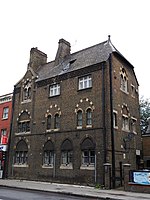St Anne's Church, Vauxhall
1907 establishments in England20th-century Roman Catholic church buildings in the United KingdomChurches in the Diocese of SouthwarkGrade II listed churches in the London Borough of LambethLondon church stubs ... and 3 more
Roman Catholic churches completed in 1907Roman Catholic churches in the London Borough of LambethUnited Kingdom listed building stubs

St Anne's Church is a Roman Catholic church at 363 Kennington Lane, Vauxhall, London SE11. It was built in about 1903–07, designed by Frederick Walters, and has been Grade II listed since 1981. Its presbytery is the St Anne's House next door.
Excerpt from the Wikipedia article St Anne's Church, Vauxhall (License: CC BY-SA 3.0, Authors, Images).St Anne's Church, Vauxhall
Kennington Lane, London Vauxhall (London Borough of Lambeth)
Geographical coordinates (GPS) Address External links Nearby Places Show on map
Geographical coordinates (GPS)
| Latitude | Longitude |
|---|---|
| N 51.486059 ° | E -0.119885 ° |
Address
St Anne's Catholic Church
Kennington Lane
SE11 5HY London, Vauxhall (London Borough of Lambeth)
England, United Kingdom
Open on Google Maps










